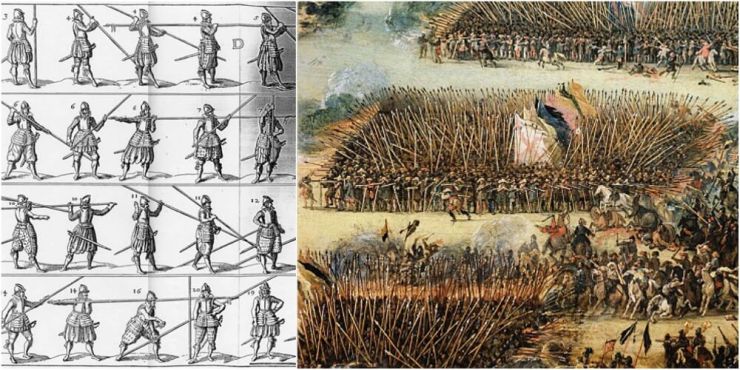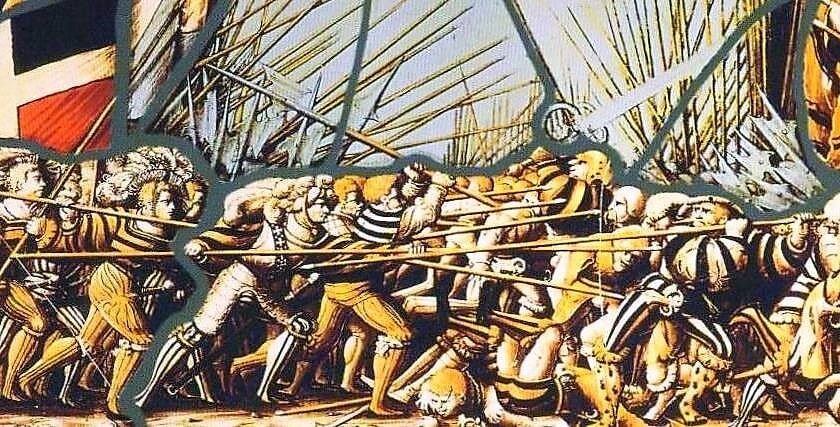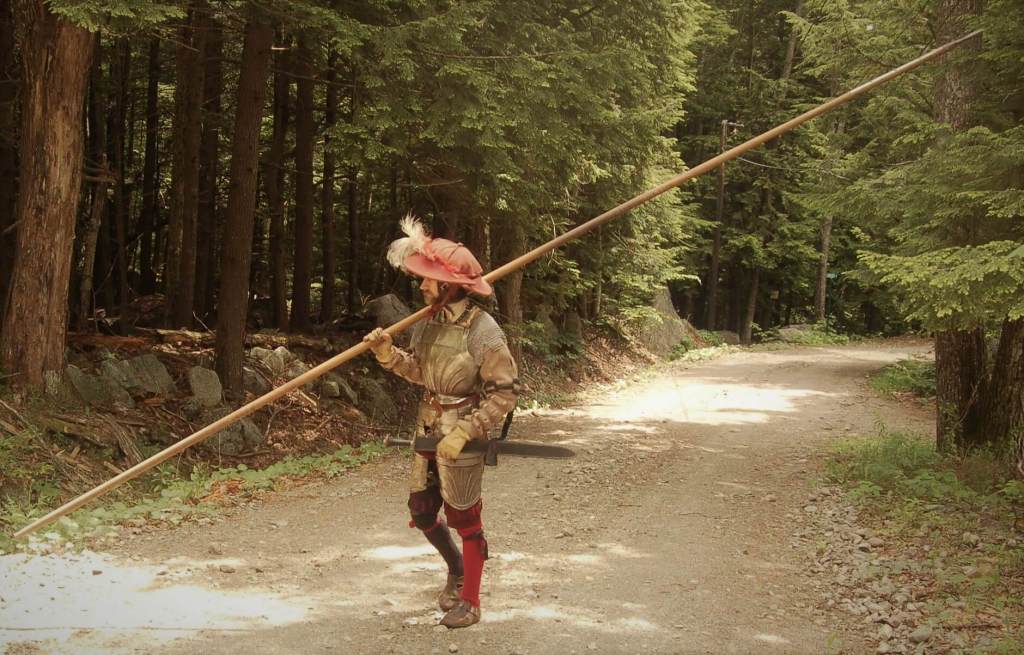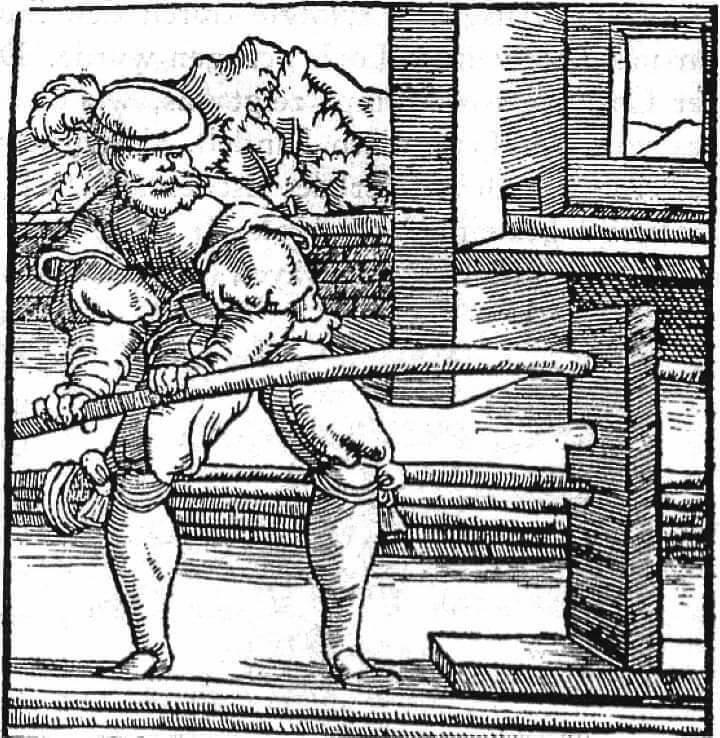The Pike: the Queen of Renaissance Battles
November 5, 2018 - Moreno Dei Ricci
original article in Italian:
http://zweilawyer.com/2018/11/05/la-picca-la-regina-delle-battaglie-rinascimentali/?fbclid=IwAR1reswqFuzVf6biGI_OHiH6xj8MChyKwxL_D7Xf0ZKrnCeSWhS969KCFNs
The Pike is an infantry weapon that became famous thanks to the Macedonian phalanxes of Alexander the Great. Through their formidable Sarisses, the disciplined hoplites of Macedonia carried the banner of their king to the ends of the ancient world. After having having been forgotten in the Middle Ages, the pike reappears in the Renaissance period, between the end of the fifteenth and the beginning of the sixteenth century, where it became the weapon of choice for military units specialized in its use, like those of Switzerland and Lanzi; afterwards it became an ordinance armament, together with the arquebus, the tercios, the mixed formations of the Spanish infantry of the Siglo de Oro.
"Del Combattere de Picha overo Lancioto da Fante a piede" Marozzo Chapter 182, Book Four, Opera Nova 1536. It is with these words that the Renaissance Master of Arms Achille Marozzo introduces in his treatise the use of the pike, one of the sovereign weapons of the battlefields of the sixteenth century. This long weapon achieves great effectiveness in warfare in the formations in "Closed Order", or the disciplined Square of Pikes; it is these highly specialized troops that made the infantry once again the queen of the battlefields after hundreds of years of dominance by cavalry. In particular, the Italian Wars were the theater of this thousand-year challenge between these two "classes", and the altar on which History consecrated the winner: the Infantry, in its renewed and more efficient expression. There are countless chronicles that demonstrate the great effectiveness of the Squares of Pikes, both in terms of contrast to the cavalry and in the employment against other infantry.
No resident warlord would have waged a war without the "certainty of having those Swiss or lanzichenec squares that are so good in cases of need". The value of the specialized formations of pikemen soon became legendary; there are many cases in which these units were hired by Captains for the sole purpose of being seen on the battlefield, in the certainty that they would galvanize their troops and intimidate their adversaries.
This is demonstrated during the siege of Milan in July 1526, where the Duke of the Rovere refused to proceed with the assault, as he yet did not have the 10,000 Swiss who he had hired: "The Duke (of Urbino) relies much in the Swiss, insisting that "without this shoulder we are not going to be steadfast ... with them (the Swiss) you can be sure of the fear that they do to the enemies if they have to come up against the pike."
We must bear in mind that the success of the infantry units was not exclusively due to the strength of the pikemen, but also to all the specialized support troops that accompanied them. During those battles these were the "aces up the sleeve": the Alabardieri (halberdeers), the Rotellieri (shield men) and the dreaded soldiers armed with two-handed broadswords, who had the difficult task of creating havoc among their opponents, opening gaps in the enemy formations with the skillful swinging of their blades. The Archibugiers (gunners) completed the mixed formations, a percentage that would increase significantly during the seventeenth century.
In any case, the pike remained the backbone of the Infantry Squares and according to the period and the mode of use it could have different dimensions, from a minimum of 3.5 meters up to over 6 meters; we are therefore talking about an extremely cumbersome weapon and complex management, especially if we consider its use in the context of a battle, where the infantryman is subject to different forms of physical and psychological pressure.
The use was therefore to be formed according to a strict training:
"The handling of the pike was difficult and required a long apprenticeship and marching to a cadenced pace ... Between 16 and 18 you learned the handling of the pike and the discipline of training: a rough school where the weakest were eliminated. Training was also taken to endure long runs, and to fight against knights in close combat. In this operation the students slipped among the galloping horses of the enemies, seized the blows, the bridles of the riders and pulled them from the saddle."The development of physical skills went hand in hand with technical improvement: the secrets of the trade were transmitted only to the members of their family or their own village. Nothing remains of this mastery, because no one preserved this tradition in writing. The handling of the pike was a family's jealously guarded secret; just think of the Swiss who fought side by side with brothers, cousins ??and uncles, and with fellow citizens from the same towns or villages; this association between countrymen and blood relations obviously cemented a very strong common spirit as well as deep synergies in the combat formation. In this way whole battalions were formed, composed of hard people, accustomed to the rigors of military life, professionals who made War their trade.
Another factor in the success of these formidable warriors was the speed of maneuver and the high fighting spirit. It was not enough to have many men on the battlefield who knew how to use the pike in tight formations, they also had to be extremely flexible and be able to swiftly attack the opponent with lightning engagements, coordinating the formation even in the chaos of the battle and tempering their aggression.
The Swiss had always been the pioneers of this strategy. For many hundreds of years the infantry had carried out a predominantly static battlefield strategy "by planting their shields on the ground and forming a wall with outstretched spears, so as to create support for the cavalry". That is how the Lombardic Fanysts of the 13th century are described: a static battle arrangement where the infantry had almost the exclusive task of creating barriers and offering shelter to the cavalry, behind whose lines the cavalry could reorganize itself between each offensive episode. In the Renaissance, as we have seen, an historical reversal of roles instead took place.
Very few testimonies remain of the skill with which these pikemen used the pole, coordinating in tightened formations; however, the comparative analysis of some sources can offer us valuable tools to clarify and try to rebuild their combat system, the training methods and group coordination through which these veterans of the Renaissance wars have become so famous today and feared in their time. Some chronicles and some iconographic sources (paintings and engravings) can provide information about the two main ways of holding the pike. One source over all others is to be considered precious for the purpose of our study, since it is a direct testimony from the field of battle. Biagio de Monluc, French leader and chronicler, gives us a rather clear description of how to challenge the pike during the battle of Ceresole in 1544. Monluc, commanding the Gascon infantry who were about to clash with the lansquenets, shouted to his men: "My companions, there may not be warriors here who have been in battle. If we take the pike at the end and fight with all its length, we are defeated, because the Alemanni are more skilled than us in this practice! But you must hold the pike in half like the Swiss do, and lower the tip to pierce and move on, and you will surprise your enemies."
The Captain and Master in the Art of Arms, Pietro Monte, during the battle of Rio Secco of 1508, knowing that his Venetian infantrymen would clash with those Alemanne, preferred another strategy and ordered that the pikes should be lengthened by 60 cm, so as to have advantage over the adversary, and this cleverness gave him the victory on the field. If we compare Monluc's detailed description with this iconographic reference, we can already have a rather complete view of the ways in which the pike was challenged.
Hans Funk Stained glass window 1532 ca. Battle of the Ariotta 1513. Left side Swiss picchieri against the Lanzichenecchi colleaguesHoplology (a science that studies human combative behavior and performance) is another way that supports the comparative study of sources; it is in fact essential to touch the tools of the trade with this hand to be able to approach the renaissance infantry "system" more correctly. Knowing the technical characteristics of the weapon, we can have a clearer idea in order to confirm our hypotheses and interpretations.
Unfortunately, the limit of all the military artifacts is obviously the deterioration of wood, an organic material that can rarely survive from that time to today. The few surviving artifacts and the various testimonies of that time (the first quarter of the 16th century) tell us about solid ash rods of an important weight and diameter that started from the final part of the shaft, and tapered up to where the shaft was inserted into the metal tip; this was reinforced by side bands to prevent the tip from breaking off and at the same time protecting the wood from the impact of combat. A very important consideration is that the production of the pike, being a weapon of considerable length and specific technical requirements, needed craftsmen with a great experience in the production of rods and irons to produce them. The sources in this regard are very poor, but even here the great humanists of the past left testimonies on the production of these weapons. The first information that emerges leads us to believe that the wood crops for these long shafts were regulated, as was already the case for the timber destined for the construction of oars for war galleys, with the identification of portions of forests marked for the their production.
Reconstruction of Pike Alemanna from 1520 - Lanzichenecco re-creator: weight of the pike in ash 10kg approx.A very interesting source is the Report of the Venetian Provveditore Giovanni Da Lezze, who draws up a detailed report of the production sites in Bergamo, in which he collects information related to the procurement of armaments on behalf of the Republic of Venice. It is interesting to consider the production capacity of a Follo (workshop) of a gunsmith, and find among his works weapons including the pike: "A fusion of cutting weapons that a man works with every day n.25 ... daggers and knives n.46 ... spontons n.75 ... halberds & pikes, hooked spears, cortellazzi and other similar weapons n.18 ... ".
The source is obviously to be interpreted; "homo" means usually the Master Armor, who had a staff of forge workers, more or less specialized, capable of producing these huge quantities of weapons. The supply of firearms was understood to already include the wood on which the iron was mounted, with straps and any reinforcements; it was therefore the duty of the Armaiolo to deal with the identification of the raw material and the processing of the seasoned ash to create the robust poles. Bergamo and Brescia were famous for the production of weapons, among them pikes, and the Estimates report a large number of master armor smiths specialized in the production of these weapons, called "Mastri Lanzari", the greatest numbers of which start from the last quarter of the 16th century and lasted until the early part of the 17th century.
It is also interesting to discover the procedures for the construction of a 4 to 6 meter long pole, perfectly straight and of adequate strength. The source that reports this is a German press of the early 16th century, where is shown a craftsman who, through a special tool, straightens long shrubs for the production of spade rods; this process is very similar to that used until a few years ago for the production of wood for agricultural tools in the rural communities:
Print from the Swiss chronicles by Johan Stumpf of 1586 - the manufacturer of spike-source found by HROARR by R. NorlingThere remains, therefore, a last aspect to face, and that is the purely technical use of a weapon so particular, with unique characteristics in terms of weight and size. We have seen how specialized units held the pike and how they were organized, but we have yet to see how it was actually used in the combat being performed. To shed light on this important aspect, Renaissance treatises could certainly not be omitted, for they precisely reveal the use of these weapons.
In the sixteenth century we find one of the greatest exponents in this art, Achille Marozzo, who devotes an entire book in his "Opera Nova" of 1536 to the use of these weapons. Specifically, we refer to Chapter 182 - Fourth Book "On the combat of the pike or spear, one on one", specifying in the introduction "from Foot to Foot". We are in the presence of a discovery of great importance: the first written testimony of a system of use of the pike related to the period of our interest-- the infantry formations of the early sixteenth century. Many Italian Masters reveal the use of weapons during the late Middle Ages and early Renaissance, such as Fiore dei Liberi or Filippo Vadi, but Marozzo is the first author to deal systematically the use of the Pike. Even in the German-speaking countries, other Masters after him face the use of very long poles, such as the famous Joachim Meyer (Swiss among others) in his splendid treatise "Gründtliche Beschreibung der kunst des Fechten" of 1571.
What emerges in the "Opera Nova" treaty is a system of absolute essentiality, just as it could not have been otherwise; a weapon so long and of considerable weight allows only a limited range of actions, a nucleus of a few simple and dry gestures. However, the refinement of Marozzo's fencing system finds expression in this gestural economy: the Master compensates for the limitation of the complex movements of the weapons by developing some passages of extraordinary beauty and effectiveness.
In addition to the classic ascending and descending thrusts, and the parries that laterally strike the adversary's pole, we find an elegant "Camuffo" of the pike, that movement which, passing under the opponent's pole, changes its position through a cavazione. "Camouflaging the hand" teaches us the change of the forward hand compared to the rear one, with consequent replacement of the forward shoulder, changing at the same time also the forward leg to perform a change of guard. Another refinement appears in the walk called "de Squillo", that is the crossing of the rear leg behind the forward one, so as to transform one's own figure and offer less of a target for the attacks of the enemy. At the same time when we perform this step, which allows us to find the opponent's side more easily due to the acquired degrees, we will pull a "launch". This synergy between the walk and a dry, rational swing of the weapon, gives life to an extremely effective system, which provides the essential elements to be able to reconstruct the wartime use of the pike by specialized units.
The curious aspect found by reading Marozzo is the way in which the pike is held, which seems to be the "lanzichenecca", that is with the back hand near the Calzo dell'asta, or pedal, and not half (as presumably the Swiss units did, described previously in the chronicle of Biagio de Monluc). To complete the system, the Master also contemplates the possibility of going to what is called the "Tight Game", and grappling the opposing staff.
The grappling is only marginally presented in the chapter of the pike, but we find a mention in chapter 183 in the "On the combat of the winged spear, person to person", where after going in close with the opponent, he advises to unsheath the sword or dagger and to hit his side or to pull a cut to the legs. In this interesting passage, the presence and military use of the famous "Katzbalger" (alongside each lanzichenecco) or the classic dagger commonly supplied to Renaissance infantrymen is justified.
While the infantry march through the wars of the Renaissance and the bloody seventeenth century, the pike continues to remain the most used line weapon. The Trattatisti indulge themselves in beautiful summaries in which are exposed all the essential ways in which the pike must be kept, in every phase of the military campaign. It emerges that the captain must ensure the proper training of the novice soldiers on how to carry the pike: "I will teach them to wear the pike perfectly, keeping the hand at shoulder height and the elbow up, with the right hand to the side or to the dagger; to walk at a brisk pace, and make sure that by marching the kick of the pike does not pass the knee joint of the forward row. When it is to be used against the enemy, put the pedal well on the ground, so that it is more stable and safe."
All these aspects are accurately described by Maestri as Francesco Alfieri, who speaks of it in his work of 1641, or as the ceremonious and elegant Master of Arms Marin Bresciani writes his treatise "li Trastulli Guerrieri" in 1668, where, beyond a detailed description of how a good soldier should keep the pike on every occasion (from the march to the deployment, until the strategic retreat), discusses what he calls the "Volate", a review of embellishments, virtuosity and prowess.
It was customary at the time that a Captain of Infantry Gentleman, having to prove his skill and expertise in the use of the pike, throw it in the air, making it twirl and then retrieve it with wonderful acrobatics; sometimes the sword was used to collect the pike and to make elegant reverences to the worthy public.
Images of the picca treaties of: 1. Achille Marozzo. 2. Francesco Alfieri. 3. Marin Bresciani.As we have seen, the pike has undoubtedly been one of the weapons protagonists of the Western Military History, a technological innovation that allowed a radical change in the social geography of conflicts, rehabilitating the infantry depreciated by the medieval war. At the dawn of modernity, it reappeared not as the archaic Sarissa of Alexandria, but as the symbol of a New World: the Destiny of the nations of Europe, had risen from on the back of a horse to the tip of a pike. The masses had entered the war.
FINIS. LAUS DEO. AMEN
"May the brave recognize each other from the lances that are thrust, because the ancient glories of the Doric warriors were always an example in the eyes of the burning hearts of Glory of all time". MoR
Moreno Dei Ricci for Zhistorica, GAIRETHINX Study Center, Guardia Di Croce Weapons Room, OPERA NOVA Martial Arts School
I dedicate this article to all my Brothers of Arms of the School of Martial Arts "OPERA NOVA" and Sala d'Armi Guardia Di Croce, who with passion and constancy contribute to make these words tangible through the study of the gestures of the ancient Masters in Art of Arms. BEYOND!
Essential bibliography:
Francesco Guicciardini [Historia di Italia - 1561]
Giovanni Da Lezze [Description of Bergamo and its territory. 1596]
Biagio de Monluc [Commentaires of 1577 ca]
Achille Marozzo Bolognese [Opera Nova of 1536 - preserved in the MAM of Brescia]
Joachim Meyer [Gründtliche Beschreibung der kunst des Fechten ed. Of 1571. - preserved in the MAM of Brescia]
Francesco Alfieri [La picca - In Padoua for Sebastiano Sardi, 1641. - preserved in the MAM of Brescia]
Marin Bresciani [Li Trastulli Guerrieri 1668 - Conserved in the MAM of Brescia]
Giuseppe Nova. Data processing by L. Boschetti and M. Dei Ricci [Research Archive of the State of Brescia - Estimates of Corporations S. Faustino / Giovanni / Citta Nuova / Citta Vecchia - Armaioli di Brescia]
Francesco Rossi [Bresciani Armeoli and Armor of the '400 - 1971 edition commentaries of the University of Brescia]
A.A. Sepia [Municipalities in war: arms and armies in the Italy of cities]
Roberto Gotti [Cain - 2012 edition]
Mario Troso [The arms in the auction of European infantry from 1000 to 1500 / The last battle of the Middle Ages. The Battle of the Ariotta, Novara 6 June 1513 / Italy! Italy! 1526-1530. The first Italian war of independence]Published in White Weapons Tested Renaissance infantry, formation of pikemen, Renaissance war, wall of spades, pike, pike and musket, Swiss pikemen, square of spades, Swiss square, forest of spades, treated medieval fencing, use of the pike




